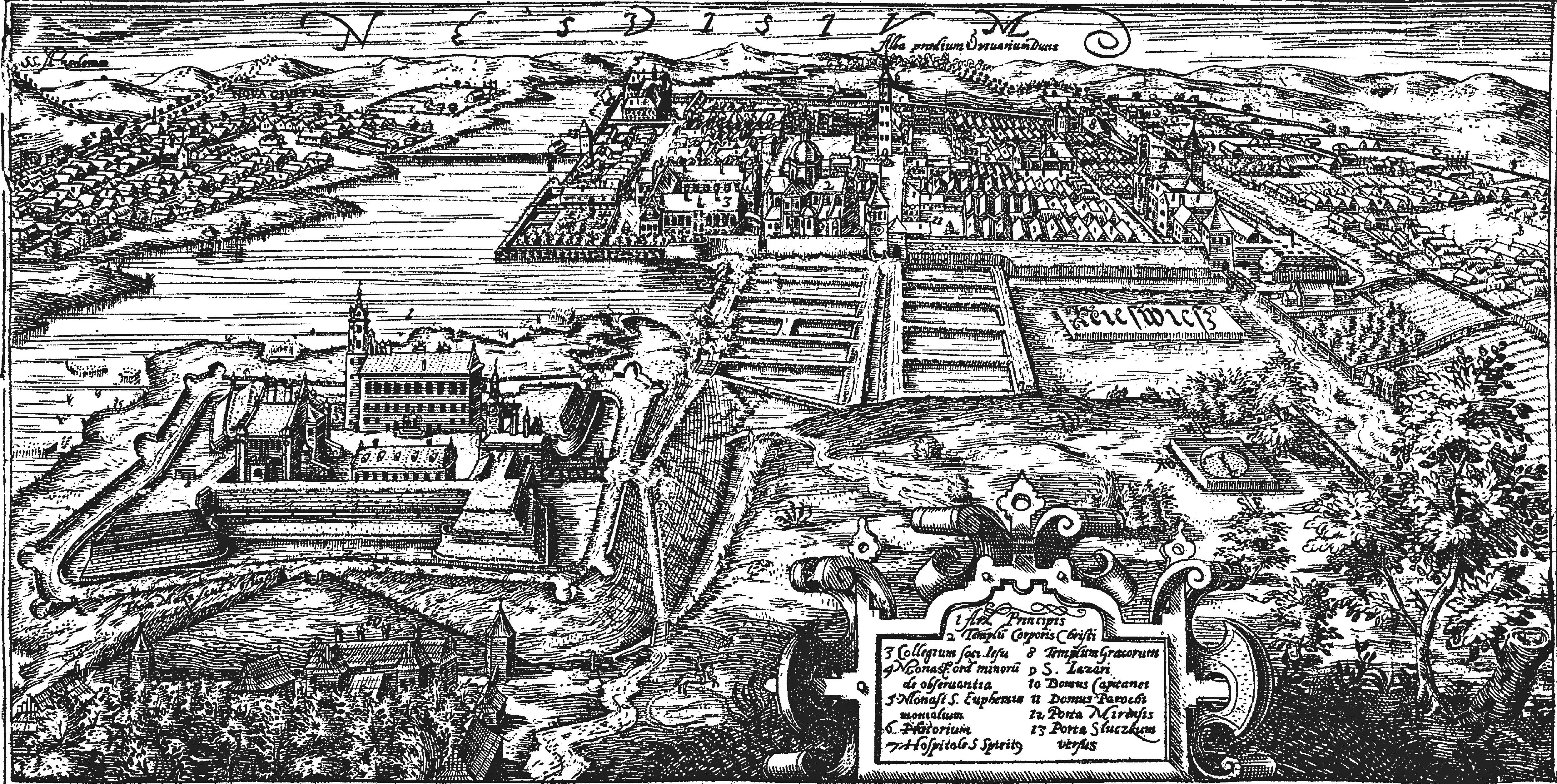|
Nieśwież
Nesvizh, Niasviž ( be, Нясві́ж ; lt, Nesvyžius; pl, Nieśwież; russian: Не́свиж; yi, ניעסוויז; la, Nesvisium) is a city in Belarus. It is the administrative centre of the Nyasvizh District (''rajon'') of Minsk Region and site of Niasviž Castle, a World Heritage Site. Its 2009 population is 14,300. History Nesvizh was first documented in 1223. It was part of the Grand Duchy of Lithuania until 1793, but the Grand Duchy was part of the Polish–Lithuanian Commonwealth since 1569. In the 15th century, while still a minor town, it belonged to the Kiszka family and later to the Radziwiłł family, and remained the family's seat until 1813. In 1561 or 1562 Maciej Kawęczyński founded the print works of the Polish Brethren. The first Belarusian language book printed in Latin script, a catechism by Symon Budny, was published in Nesvizh in 1562. The ''Nieśwież Bible'' ('' Biblia nieświeska''), one of the oldest Polish translations of the Bible, also b ... [...More Info...] [...Related Items...] OR: [Wikipedia] [Google] [Baidu] |
Radziwiłł Family
The House of Radziwiłł (; lt, Radvila; be, Радзівіл, Radzivił; german: link=no, Radziwill) is a powerful magnate family originating from the Grand Duchy of Lithuania and later also prominent in the Crown of the Kingdom of Poland. The family was founded by Radvila Astikas, but over time it split into many branches, such as the Biržai-Dubingiai and Goniądz-Meteliai lines. However, most of the branches became extinct by the 18th century, with only the Nesvizh-Kleck-Ołyka line surviving to this day. Their descendants were highly prominent for centuries, first in the Grand Duchy of Lithuania, later in the Polish–Lithuanian Commonwealth and the Kingdom of Prussia. The family produced many individuals notable in Lithuanian, Polish, Belarusian, German as well as general European history and culture. The Radziwiłł family received the title of ''Reichsfürst'' (prince) from the Holy Roman Emperor in the mid 16th-century. The Nesvizh Castle complex, maintained by the ... [...More Info...] [...Related Items...] OR: [Wikipedia] [Google] [Baidu] |
Mikołaj Krzysztof "the Orphan" Radziwiłł
Prince Mikołaj Krzysztof Radziwiłł ( lt, Mikalojus Kristupas Radvila Našlaitėlis) (2 Augustus 1549 – 28 February 1616) and nicknamed "the Orphan" ( pl, Sierotka, lt, Našlaitėlis), was a Polish–Lithuanian nobleman (szlachcic), Ordynat of Nyasvizh from 1586, Court Marshal of Lithuania from 1569, Grand Marshal of Lithuania from 1579, castellan of Trakai from 1586, voivode of Trakai Voivodeship from 1590, voivode of Vilnius Voivodeship from 1604 and governor of Šiauliai. After the treaty at Vienna in 1515 all Radziwills were Imperial Princes and he held a position as Imperial Prince of the Holy Roman Empire. Biography He was nicknamed "the Orphan", in his infancy, by the Polish king Sigismund II Augustus (while his parents were still alive). He married Halaszka Eufemia Wiśniowiecka on 24 November 1584, a Calvinist who under his influence too converted to Roman Catholicism. He took part in the Livonian War against Muscovites.Peter Paul BajeShort history of th ... [...More Info...] [...Related Items...] OR: [Wikipedia] [Google] [Baidu] |
Nesvizh Castle
Niasviž Castle or Nesvizh Castle ( be, Нясьвіскі замак, Niasvižski zamak, russian: Несвижский замок, pl, zamek w Nieświeżu, lt, Nesvyžiaus pilis) is a residential castle of the Radziwiłł family in Niasviž, Belarus. It is above sea level. Built in the 16th and 17th centuries, and maintained by the Radziwiłł family until 1939, the castle and the nearby Corpus Christi Church were instrumental in the development of Central European and Russian architecture. In 2005, the castle, church, and surrounding environment were inscribed on the UNESCO World Heritage List. History The estate was owned by the Radziwiłł magnate family from 1533, when it was awarded to Mikołaj Radziwiłł and his brother Jan Radziwiłł after the extinction of the Kiszka family. Since the Radziwiłłs were one of the most important and wealthy clans of the Grand Duchy of Lithuania and the Crown of the Kingdom of Poland, it was there that the Lithuanian Archive ... [...More Info...] [...Related Items...] OR: [Wikipedia] [Google] [Baidu] |
Symon Budny
Szymon Budny or Symon Budny ( be, Сымон Будны, pl, Szymon Budny, russian: Симеон Будный; c.1533, Budne – 13 January 1593, Vishnyeva) was a Polish- Belarusian humanist, educator, Hebraist, Bible translator, Protestant reformer, philosopher, sociologist and historian, active in the territory of the Polish–Lithuanian Commonwealth. He was one of the first to promote the development of Belarusian culture in the Belarusian language. He was one of the leaders of the Polish Brethren. Place of birth Little is known about his place of birth. Though the common assumption is that he was born in Budne, Podlaskie Voivodeship, it is known that there were over 140 places with a similar name on the territory of Belarus. Though what is known is that he was familiar was the Belarusian culture first-hand and dedicated a big part of his life to promoting it. The family he was born into was a minor Belarusian szlachta. Symon Budny originally identified himself as a Litvin, ... [...More Info...] [...Related Items...] OR: [Wikipedia] [Google] [Baidu] |
Minsk Region
Minsk Region or Minsk Oblast or Minsk Voblasts ( be, Мі́нская во́бласць, ''Minskaja voblasć'' ; russian: Минская о́бласть, ''Minskaya oblast'') is one of the regions of Belarus. Its administrative center is Minsk, although it is a separate administrative territorial entity of Belarus. As of 2011, the region's population is 1,411,500. Geography Minsk Region covers a total of 39,900 km², about 19.44% of the national total area. Lake Narach, the largest lake in the country, is located in the northern part of the region. There are four other large lakes in this region: Svir (8th largest), Myadel (11th largest), Syalyava (14th largest) and Myastro (15th largest). It is the only region of Belarus whose border is not part of the international border of Belarus. History Beginning the 10th century, the territory of the current Minsk Region was part of Kievan Rus', the Principality of Polotsk, and later it was included in the Grand Duchy of Lithua ... [...More Info...] [...Related Items...] OR: [Wikipedia] [Google] [Baidu] |
Magdeburg Rights
Magdeburg rights (german: Magdeburger Recht; also called Magdeburg Law) were a set of town privileges first developed by Otto I, Holy Roman Emperor (936–973) and based on the Flemish Law, which regulated the degree of internal autonomy within cities and villages granted by the local ruler. Named after the German city of Magdeburg, these town charters were perhaps the most important set of medieval laws in Central Europe. They became the basis for the German town laws developed during many centuries in the Holy Roman Empire. The Magdeburg rights were adopted and adapted by numerous monarchs, including the rulers of Bohemia, Hungary, Poland and Lithuania, a milestone in the urbanization of the region which prompted the development of thousands of villages and cities. Provisions Being a member of the Hanseatic League, Magdeburg was one of the most important trade cities, maintaining commerce with the Low Countries, the Baltic states, and the interior (for example Braunschweig). ... [...More Info...] [...Related Items...] OR: [Wikipedia] [Google] [Baidu] |
Jesuits
The Society of Jesus ( la, Societas Iesu; abbreviation: SJ), also known as the Jesuits (; la, Iesuitæ), is a religious order (Catholic), religious order of clerics regular of pontifical right for men in the Catholic Church headquartered in Rome. It was founded in 1540 by Ignatius of Loyola and six companions, with the approval of Pope Paul III. The society is engaged in evangelization and apostolic ministry in 112 nations. Jesuits work in education, research, and cultural pursuits. Jesuits also give retreats, minister in hospitals and parishes, sponsor direct social and humanitarian ministries, and promote Ecumenism, ecumenical dialogue. The Society of Jesus is consecrated under the patron saint, patronage of Madonna della Strada, a title of the Blessed Virgin Mary, and it is led by a Superior General of the Society of Jesus, Superior General. The headquarters of the society, its Curia, General Curia, is in Rome. The historic curia of Ignatius is now part of the attached to t ... [...More Info...] [...Related Items...] OR: [Wikipedia] [Google] [Baidu] |
Benedictines
, image = Medalla San Benito.PNG , caption = Design on the obverse side of the Saint Benedict Medal , abbreviation = OSB , formation = , motto = (English: 'Pray and Work') , founder = Benedict of Nursia , founding_location = Subiaco Abbey , type = Catholic religious order , headquarters = Sant'Anselmo all'Aventino , num_members = 6,802 (3,419 priests) as of 2020 , leader_title = Abbot Primate , leader_name = Gregory Polan, OSB , main_organ = Benedictine Confederation , parent_organization = Catholic Church , website = The Benedictines, officially the Order of Saint Benedict ( la, Ordo Sancti Benedicti, abbreviated as OSB), are a monastic religious order of the Catholic Church following the Rule of Saint Benedict. They are also sometimes called the Black Monks, in reference to the colour of their religious habits. They ... [...More Info...] [...Related Items...] OR: [Wikipedia] [Google] [Baidu] |
Bible Translations Into Polish
The earliest Bible translations into Polish date to the 13th century. The first full ones were completed in the 16th. Background The history of translation of books of the Bible into Polish begins with the Psalter. The earliest recorded translations date to the 13th century, around 1280; however, none of these survive. ks. prof. dr Jan SzerudGeneza i charakter Biblii Gdańskiej The oldest surviving Polish translation of the Bible is the St. Florian's Psalter (''Psałterz floriański''), assumed to be a copy of that translation, itself a manuscript of the second half of the 14th century, in the abbey of Saint Florian, near Linz, in Latin, Polish and German.Bernard Wodecki, ''Polish Translations of Bible'', in A critical edition of the Polish part of the St. Florian's Psalter was published by Wladysław Nehring (''Psalterii Florianensis pars Polonica'', Poznań, 1883) with a very instructive introduction. Slightly more recent than the St. Florian's Psalter is the Puławy ... [...More Info...] [...Related Items...] OR: [Wikipedia] [Google] [Baidu] |
Republic Of Belarus
A republic () is a "state in which power rests with the people or their representatives; specifically a state without a monarchy" and also a "government, or system of government, of such a state." Previously, especially in the 17th and 18th centuries, the term was used to imply a state with a democratic or representative constitution (constitutional republic), but more recently it has also been used of autocratic or dictatorial states not ruled by a monarch. It is now chiefly used to denote any non-monarchical state headed by an elected or appointed president. , 159 of the world's 206 sovereign states use the word "republic" as part of their official names. Not all of these are republics in the sense of having elected governments, nor is the word "republic" used in the names of all states with elected governments. The word ''republic'' comes from the Latin term ''res publica'', which literally means "public thing", "public matter", or "public affair" and was used to refer t ... [...More Info...] [...Related Items...] OR: [Wikipedia] [Google] [Baidu] |
Catechism
A catechism (; from grc, κατηχέω, "to teach orally") is a summary or exposition of doctrine and serves as a learning introduction to the Sacraments traditionally used in catechesis, or Christian religious teaching of children and adult converts. Catechisms are doctrinal manuals – often in the form of questions followed by answers to be memorised – a format #Secular catechisms, that has been used in non-religious or secular contexts as well. According to Norman DeWitt, the early Christians appropriated this practice from the Epicureans, a school whose founder Epicurus had instructed to keep summaries of the teachings for easy learning. The term ''catechumen'' refers to the designated recipient of the catechetical work or instruction. In the Catholic Church, catechumens are those who are preparing to receive the Sacraments of the Catholic Church, Sacrament of Baptism. Traditionally, they would be placed separately during Holy Mass from those who had been baptized, and wo ... [...More Info...] [...Related Items...] OR: [Wikipedia] [Google] [Baidu] |






